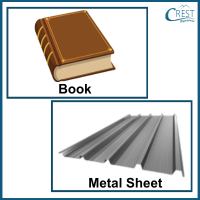1. When Gina uses a pinhole camera to observe her school bus, what would she observe?
a) A larger and magnified image of the school bus.
b) A clear and detailed image of the school bus.
c) No image would be visible through a pinhole camera.
d) An inverted and smaller image of the school bus.
Answer: d) When using a pinhole camera, the small hole acts as a lens, allowing light rays from different parts of the school bus to enter and form an image on a screen inside the camera. The image formed by a pinhole camera is typically inverted, meaning it appears upside down compared to the actual object. Additionally, the image produced on the screen is smaller in size than the school bus.
2. Rosa glanced at the view outside her house through the frosted window. What is she likely to observe?
a) A clear and unobstructed view of the weather outside.
b) A distorted and hazy view of the weather outside.
c) No view at all, as the frosted window blocks the visibility completely.
d) A magnified and enhanced view of the weather outside.
Answer: b) Frosted windows have a textured or patterned surface that scatters the incoming light. As a result, the view through a frosted window appears distorted and hazy, making it difficult to see the weather outside with clarity. The scattering of light by the frosted surface creates a diffused effect, blurring the details of the view.
3. What would happen to the path of light if it encounters the following objects?

a) Light would change its direction abruptly
b) Light would continue to travel in a straight line without any deviation
c) Light would slow down and move in a curved path
d) Light would not pass through the objects
Answer: d) When light encounters an opaque medium, such as a wall or a metal, it cannot pass through the medium. Opaque objects block the passage of light, resulting in no transmission of light through the material.
4. Identify the objects that allow light to pass through them from the following list.
I. Optical lenses
II. Rice paper
III. Clear plastic
IV. Ceramic objects
V. Mirror
VI. Tinted glass
a) I, V and VI
b) III and V
c) I and III
d) I, III and V
Answer: c) Optical lenses and clear plastic are transparent objects that allow light to pass through them without any distortions.
5. How would you make a pinhole camera using everyday materials?
a) Cut a small hole in a shoebox and place a piece of tracing paper at the opposite end.
b) Attach a magnifying glass to a camera to focus light.
c) Use a mirror to reflect light onto a screen.
d) Place a candle inside a glass jar to create a diffused light source.
Answer: a) To create a pinhole camera using everyday materials, one can take a cardboard box and make a small hole in one side. Then, at the opposite end of the box, place a translucent material like tracing paper or a white sheet. This arrangement allows light to enter through the pinhole, form an inverted image on the tracing paper, and create a basic pinhole camera.


